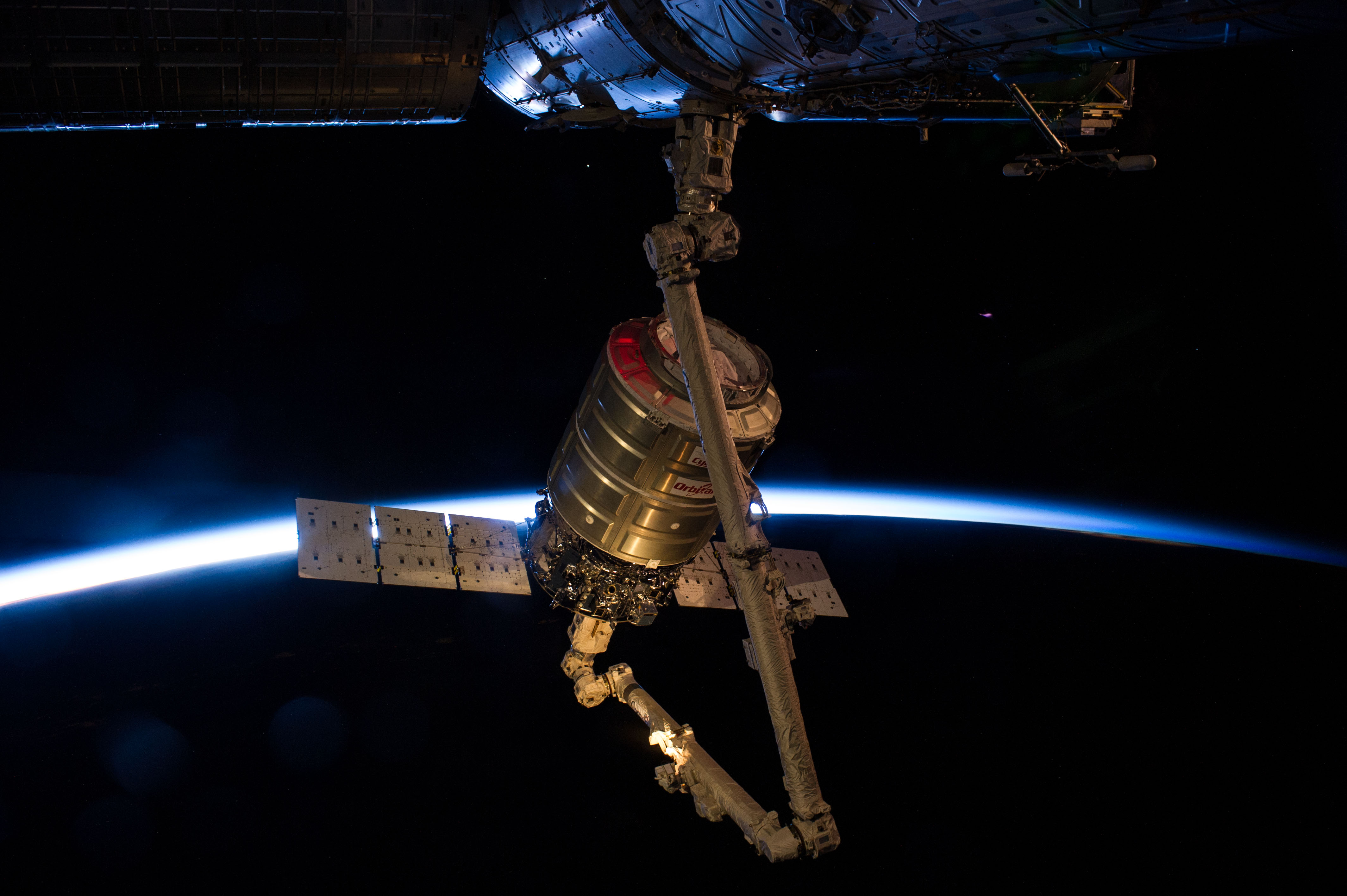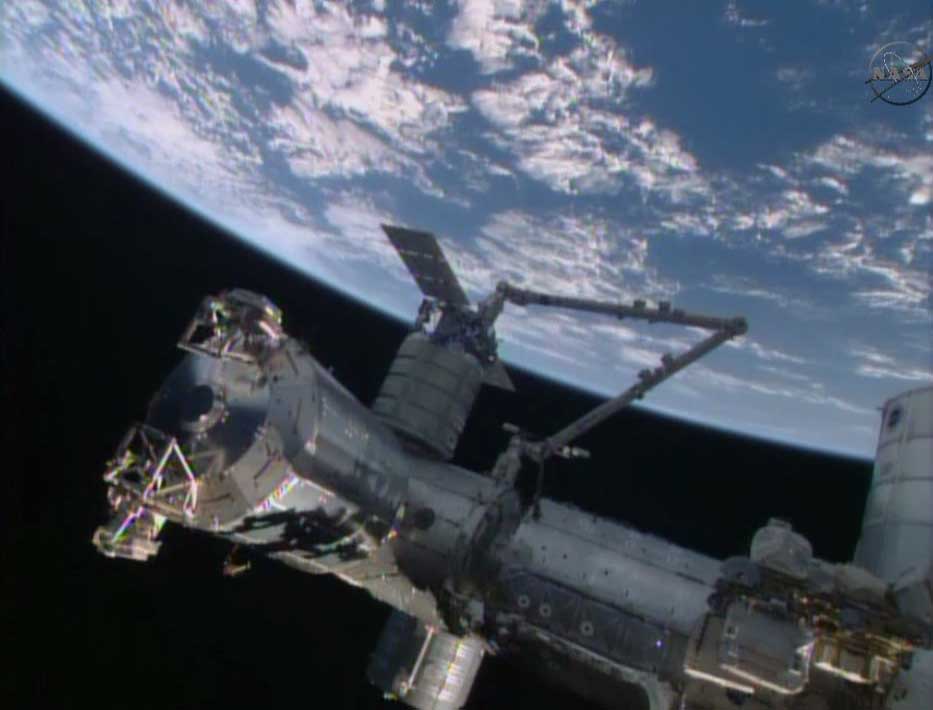The Expedition 40 crew welcomed more than a ton and a half of science, supplies and spacewalking equipment to the International Space Station Wednesday with the arrival of Orbital Sciences’ Cygnus cargo spacecraft.

Intersecting the thin line of Earth’s atmosphere, the Orbital Sciences’ Cygnus cargo craft attached to the end of the Canadarm2 robotic arm of the International Space Station is photographed by an Expedition 40 crew member after the two spacecraft converged at 6:36 a.m. EDT Wednesday. Image Credit: NASA
With Cygnus securely in the grasp of the Canadarm2 robotic arm, the robotics officer at Mission Control in Houston remotely operated the arm to guide the cargo craft to its berthing port on the Earth-facing side of the Harmony module. Once Cygnus was in position, Flight Engineer Reid Wiseman monitored the Common Berthing Mechanism operations for first and second stage capture of the cargo ship, assuring that the vehicle was securely attached to the station with a hard mate. Second stage capture was completed at 8:53 a.m. EDT.

Canadarm2 berths Orbital Sciences' Cygnus cargo vehicle to the Earth-facing port of the International Space Station's Harmony node. Image Credit: NASA TV
Cygnus was grappled at 6:36 a.m. as it flew within about 32 feet of the complex by Commander Steve Swanson — with assistance from Flight Engineer Alexander Gerst – as he controlled the 57-foot Canadarm2 from a robotics workstation inside the station’s cupola. Wiseman joined his crewmates in the seven-windowed cupola to assist with the capture and help coordinate the activities. At the time of capture, the orbital laboratory was flying around 260 statute miles over northern Libya.
Orbital Sciences named this newest Cygnus vehicle the SS Janice Voss in honor of the NASA astronaut and Orbital employee who died in February 2012. Swanson paid tribute to his former colleague after the successful grapple as he remarked, “We now have a seventh crew member. Janice Voss is now part of Expedition 40. Janice devoted her life to space and accomplished many wonderful things at NASA and Orbital Sciences, including five shuttle missions. And today, Janice’s legacy in space continues. Welcome aboard the ISS, Janice.”
After Wiseman removed the Centerline Berthing Camera System that provided the teams with a view of berthing operations through the hatch window, he pressurized the vestibule between Harmony and the newly arrived cargo craft and conducted a leak check. Once that was complete, Swanson and Gerst opened the hatch to the vestibule and outfitted the area for the opening of Cygnus’ hatch around 6 a.m. Thursday.
This is Orbital’s second cargo delivery flight to the station through a $1.9 billion NASA Commercial Resupply Services contract. Orbital will fly at least eight cargo missions to the space station through 2016.
The Orbital-2 mission delivered almost 3,300 pounds of supplies to the station to expand the research capability of the Expedition 40 crew. Among the research investigations aboard Cygnus are a flock of Earth-imaging nanosatellites, hardware to enable a trio of free-flying robots to perform 3-D mapping inside the station and a host of student experiments.
Orbital's Cygnus was launched on the company's Antares rocket at 12:52 p.m. Sunday from the Mid-Atlantic Regional Spaceport Pad 0A at NASA’s Wallops Flight Facility in Virginia. Cygnus will remain attached to Harmony until a planned unberthing August 15. After it departs the orbital laboratory, carrying about 3,000 pounds of trash with it, the spacecraft will conduct additional tests for future missions to the space station before a destructive re-entry in Earth's atmosphere.

In this photo posted to Twitter by Flight Engineer Reid Wiseman, Commander Steve Swanson gets set to install some upgrades for Robonaut 2. View tweet by @Astro_Reid
For Swanson, it was a robotics-intensive day. After spending his morning at the controls of the robotics workstation for the Cygnus capture, Swanson spent the afternoon beginning the installation of some upgrades for Robonaut 2, the humanoid robot aboard the station. Robonaut, which was delivered to the station in May 2011 during the STS-134 shuttle mission, was designed to test out the capability of a robot to perform tasks deemed too dangerous or mundane for astronauts. Mobility upgrades, including a pair of legs for Robonaut, were delivered to the station during the SpaceX-3 cargo mission in April, Starting with Wednesday’s work to install new helmet pieces and replace Robonaut’s shoulder and elbow covers, Swanson will spend four days upgrading the robot’s torso. Two additional workdays at a later date will see the installation of Robonaut’s legs.
On the Russian side of the complex, Flight Engineer Oleg Artemyev downloaded micro-accelerometer data from the Identification experiment, which measures dynamic loads on the station during events such as Wednesday’s grapple and berthing of Cygnus.
Artemyev also performed the VIRU experiment, which seeks to increase the efficiency of training and experiment operations through the use of 3D virtual manuals.
Meanwhile, Flight Engineer Max Suraev performed an inspection of the Zarya module. Also known as the Functional Cargo Block, Zarya was the first component of the space station and was launched on a Russian Proton rocket in November 1998.
Flight Engineer Alexander Skvortsov continued packing the Progress 55 cargo craft with trash and unneeded items for disposal. Progress 55 arrived at the orbiting laboratory in April and will undock from the space station's Pirs docking compartment on Monday at 5:41 p.m. The cargo ship will undergo several days of engineering tests in orbit before being commanded to re-enter Earth's atmosphere for a fiery demise over the Pacific Ocean.
The departure of Progress 55 will clear Pirs for the next Russian space freighter. On July 23, the Progress 56 resupply ship will launch at 5:44 p.m. from the Baikonur Cosmodrome in Kazakhstan (3:44 a.m. local time on July 24), with about 5,700 pounds of food, fuel and supplies for the station's Expedition 40 crew. Progress 56 will make a four-orbit, six-hour trip to the space station and dock at 11:28 p.m.
Advertisement





